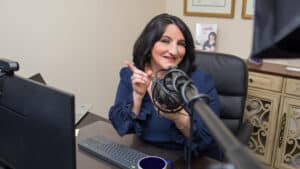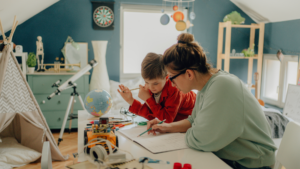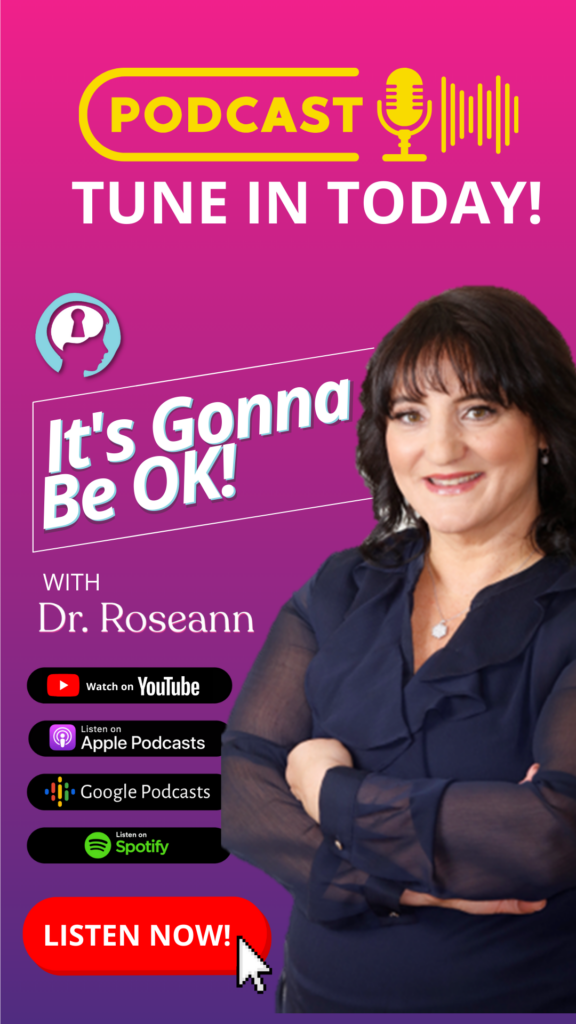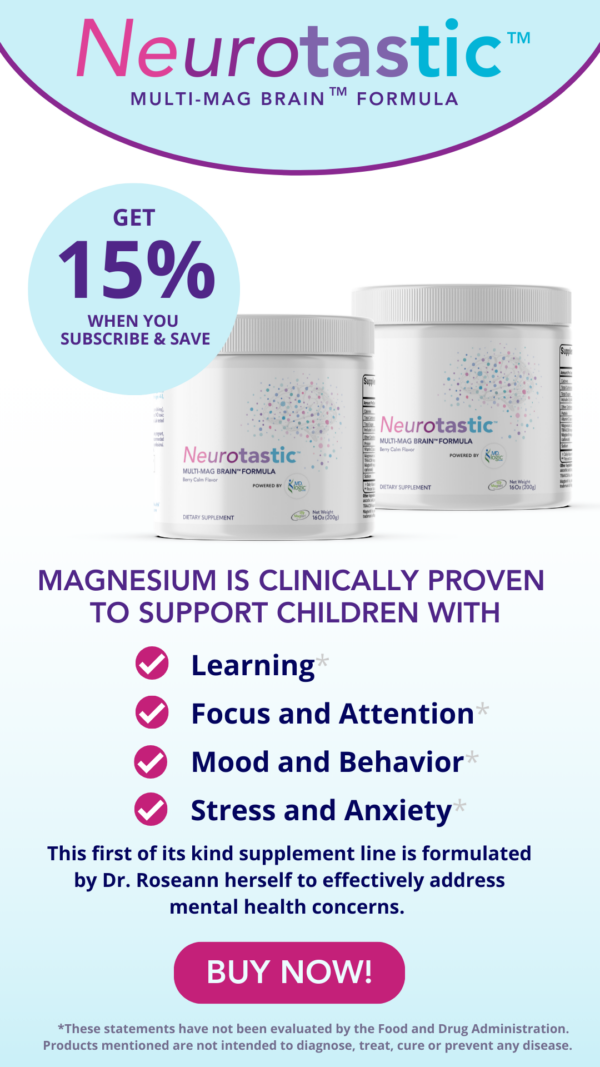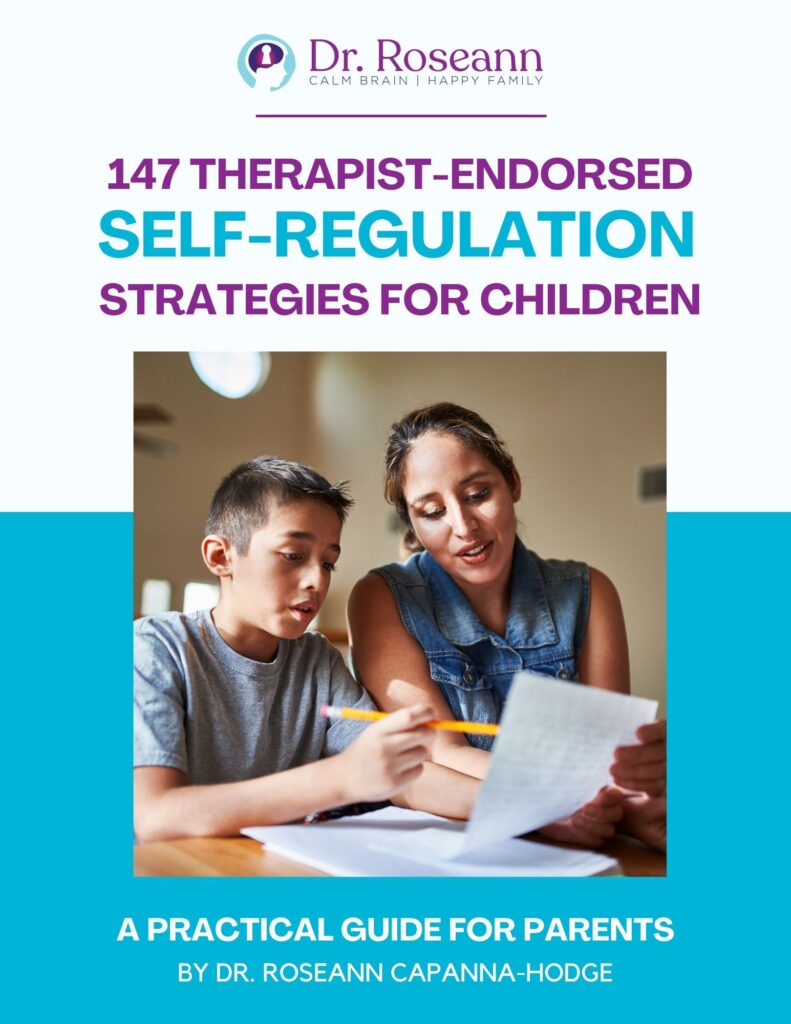You know your child has Attention Deficit Hyperactivity Disorder (ADHD) if they are unfocused, can’t follow directions, and struggle with being distractible, but there's something about all this talk of medications that just doesn’t sit right with you. As you review the list of possible side effects and your pediatrician talks about tweaking dosage, there's a feeling in your gut that just won't go away.
Is your beautiful bundle of energy going to spend the remainder of your life taking some high-priced chemical concoction? Is the only solution to controlling their emotional breakdowns, constant chatter, and random impulses contained in a plastic bottle chaining them to a regime of pills lest they suffer academically and socially?
Reducing ADHD symptoms is possible. There are natural and safe ADHD treatments that can improve symptoms related to ADHD in children and ADHD in adults too. Brain training specifically, neurofeedback therapy, is a medication-free therapy that is non-invasive and has been shown to improve focus, attention, and impulse control.
What is ADHD?
The term ADHD refers to a chronic condition known as Attention-Deficit Hyperactivity Disorder. ADHD is more than just not being able to stay focused. ADHD is a complex neurological disorder comprising a combination of issues that may include difficulty sustaining attention, hyperactivity, impulsive behavior, as well as poor executive functioning.
ADHD symptoms include more than just distractibility. Many people assume that ADHD means a child can’t focus. What they don’t realize is that hyper-focus is one of the symptoms of ADHD. When the ADHD child demonstrates an intense concentration on an area of interest, parents think, “My child can focus when he likes something, so he doesn’t have ADHD!”
Which prevents identification and in turn, denies the child much-needed ADHD treatment such as neurofeedback and supplements. These kids are often so verbal and bright that they often compensate at school with their communication schools.
ADD vs ADHD?
The terms Attention Deficit Disorder (ADD) and Attention-Deficit Hyperactive Disorder (ADHD) are often used interchangeably. ADD most often reflects a child or person who struggles with inattention.
In the most recent version of the Diagnostic and Statistical Manual (DSM), the manual reclassified ADHD into three subtypes, Predominantly Inattentive Presentation, Predominantly Hyperactive/Impulsive Presentation, and Combined Presentation.
This classification essentially makes ADD a subtype of ADHD that presents without hyperactivity and lack of impulse control. Paying attention while completing cognitive tasks is often a challenge for any individual with ADHD despite often having a higher-than-average intellect.
How Common is ADHD and Neurofeedback as Treatment?
ADHD is the second most common children’s mental health issue. In 2016, according to the CDC, 6.1 million children had an ADHD diagnosis, and that number continues to rise. One out of every ten children is identified with ADHD. Data from 2017, shows a 42% increase in ADHD diagnosis over the past several years, with 4% of American adults dealing with ADHD daily.
What is Neurofeedback and How Does It Work?
Neurofeedback is a powerful non-invasive, medication-free ADHD treatment. Some people liken it to a gaming experience but proper neurofeedback is more like a good round of exercise. Think of it as a fitness workout for your brain. By using your mind during a neurofeedback therapy session and reinforcing your subconscious, you teach your brain to change its behavior.
Unlike medication, neurofeedback side effects are few and largely benign. The most common side-effect is some mental fatigue, which makes sense. After a solid physical workout, you feel a bit tired. Naturally, if your brain experiences proper exercise, it will be tired as well.
What is Neurofeedback Therapy for ADHD?
Instead of using mind-altering medication, neurofeedback acts as a personal trainer for your brain waves. The type of waves produced by your brain changes based on whether your mind is in a focused state or not.
Neurofeedback is designed to teach your brain how to shift into a state of concentration more efficiently by learning to produce the brain waves associated with focus. Your coach, so to speak, cheers you on as your brain learns to act in a healthy way that increases focus, motivation, distractibility, and impulse control, which means fewer calls from the teacher and sibling brawls and better relationships at work or school.
Neurofeedback training is grounded in the principle that by helping the brain self-regulate over time, your brain becomes trained to produce a healthy combination of brainwaves. This results in lasting changes that make you feel calmer, more focused, and in better control of your whole self no matter what age you are.
Does Neurofeedback Work for ADHD?
Neurofeedback involves training individuals to regulate their brain activity, typically through real-time monitoring of brainwave patterns. The idea is that by providing feedback and reinforcement when desired brainwave patterns are achieved, individuals can learn to self-regulate and improve symptoms associated with conditions like ADHD.
Many children report improvements in attention and behavior after neurofeedback sessions. However, factors such as individual differences, the specific neurofeedback protocol used, and the quality of the research studies can all influence the outcomes.
How Does Neurofeedback Work for Anxiety?
Neurofeedback for anxiety aims to improve symptoms by training individuals to regulate their brainwave patterns. The process begins with an assessment of the individual's brainwave activity using a Quantitative Electroencephalogram (QEEG) to identify specific patterns associated with anxiety.
During neurofeedback sessions, individuals receive immediate visual or auditory feedback when their brain activity aligns with desired patterns, facilitating learning and self-regulation. The underlying principle is rooted in neuroplasticity, to develop adaptive neural pathways associated with reduced anxiety over repeated sessions.
How Do I Get Started With ADHD Neurofeedback Therapy?
The First Step to beginning Neurofeedback is to get a QEEG Brain Map or a brain check if you live far from our center and are doing at-home neurofeedback. A quantitative EEG (QEEG) Brain Map is a helpful diagnostic tool that looks at brainwave patterns within different regions of the brain.
In very simple terms, QEEG is a computer analysis of the EEG data, which is a measure of the surface electrical of the brain by placing a cap on a person’s head that collects EEG data. The EEG activity is recorded and statistically analyzed, and the data is compared against a database. It is a visual way to see brain functioning regarding brain waves. A QEEG gives information about the formation of brainwaves and certain brain waves are associated with certain conditions.
Unlike traditional mental health treatments, which never “checks under the hood” and only rely on guessing, a QEEG brain map gives clear diagnostic information so you can get the right diagnosis and treatment.
What do I Need to Know About Neurofeedback Treatment for ADHD?
In our BrainBehaviorReset™ Program, whether in-person in our Connecticut neurofeedback center or at-home neurofeedback, we use EEG neurofeedback in directly targeting and treating ADHD brain wave patterns. With ADHD, most of our clients do 40 more sessions, depending on the neuroplasticity of the individual's brain.
Each individual has a custom treatment plan that addresses their unique brain activity. So while many recommend 30 sessions or less, we find that the sweet spot to improve ADHD symptoms is 40 sessions. After reviewing the QEEG or brain check data and in our strategy session with Dr. Roseann, we determined the protocol and the best treatment options to address ADHD symptoms and other needs.
Will Neurofeedback Be Hard for My Child With ADHD?
Parents of children with ADHD may wonder if neurofeedback will be too difficult for their child to manage. However, neurofeedback is often a positive experience for children with ADHD and can even help them learn to sit still and focus in multiple settings because it calms and regulates the brain.
During a neurofeedback session, the child sits in front of a computer screen with sensors placed on their scalp that detect their brainwave activity. While watching a movie or show, the child receives feedback on their brain activity in real-time, intending to improve their attention, focus, and self-regulation. That reinforcement calms the brain, which is reflected in more regulated behavior.
In everyday life, children and teens with ADHD may struggle with sitting still and maintaining focus, but neurofeedback is designed to be engaging and rewarding. The interactive nature of the movies used in neurofeedback can help hold their attention and motivate them to participate in the training. As they learn to produce more of the desired brainwave patterns, they can improve their ability to sit still and maintain focus.
While some children with ADHD may find it challenging during the initial neurofeedback sessions, this is a normal part of the process. Our team is trained to work with children who struggle with attention whether working with us in our Connecticut neurofeedback center or working fully virtually with us at home.
We can adjust the training to meet the child's needs and help them become more comfortable with the process. Brain training can lead to improved attention and behavior outside of the neurofeedback sessions.
How Does Neurofeedback Work for ADHD?
Neurofeedback is a safe and effective treatment option for individuals with ADHD. Thousands of research studies conducted over the last five decades have demonstrated the efficacy of neurofeedback for ADHD symptoms (Arns et al., 2009; Heinrich et al., 2007; Sherlin et al., 2011).
Research has consistently shown significant and long-term improvements in attention, impulse control, and distractibility after neurofeedback training (Arns et al., 2014; Bakhshayesh et al., 2011; Steiner et al., 2014).
As much as 90% of individuals with ADHD who undergo neurofeedback training show improvements in symptoms (Gani & Birbaumer, 2014). Neurofeedback is a non-invasive and natural therapy that is suitable for both children and adults, and it has been proven to be a safe and effective alternative to medication for managing ADHD symptoms (Arns et al., 2009; Arns et al., 2014; Heinrich et al., 2007).
What ADHD Symptoms can Neurofeedback Improve?

Neurofeedback is an effective treatment for a wide range of ADHD symptoms. Several studies have demonstrated the efficacy of neurofeedback for ADHD, including a meta-analysis by Arns et al. (2014), which analyzed the results of 13 randomized controlled trials and found significant improvements in inattention, impulsivity, hyperactivity, executive functioning, and emotional regulation.
Other studies have reported similar findings, including a study by Sherlin et al. (2011) that found improvements in attention and behavioral symptoms in children with ADHD after neurofeedback training, and a study by Steiner et al. (2014) that found improvements in executive functioning and emotion regulation in adults with ADHD after neurofeedback training. These findings suggest that neurofeedback is a safe, natural, and effective treatment option for ADHD, with potential benefits for both children and adults.
Neurofeedback and ADHD: Symptoms and Treatment
Here are some of the ADHD symptoms that neurofeedback can help improve:
Inattention and Neurofeedback
Neurofeedback can help increase focus and attention, allowing individuals with ADHD to stay on task for longer periods. By training the brain to produce the brain waves associated with focus, individuals with ADHD can learn to sustain attention and stay focused on important tasks (Arns et al., 2014). Improving focus can have a tremendous positive impact not just on academics but also at home and on relationships.
Hyperactivity and Neurofeedback
ADHD brain training can reduce hyperactivity by teaching the brain to produce brain waves that promote calmness and relaxation. This can lead to a reduction in fidgeting, restlessness, and other hyperactive behaviors (Arns et al., 2014). By improving attention and impulse control, a child or teen can be more connected and regulated enough to complete tasks.
Impulsivity and Neurofeedback
Neurofeedback can help improve impulse control by training the brain to produce brain waves associated with self-control and inhibition. Improving impulse control in the brain can lead to a reduction in impulsive behaviors, such as interrupting others, acting without thinking, or engaging in risky behaviors (Arns et al., 2014).
Executive Functioning and Neurofeedback
Neurofeedback has been shown to enhance executive functioning, which is the set of mental skills that help us plan, organize, and complete tasks. By training the brain to produce brain waves associated with executive functioning, individuals with ADHD can improve their ability to prioritize tasks, manage time effectively, and complete tasks more efficiently (Arns et al., 2014).
Emotional Regulation and Neurofeedback
Emotional regulation is the foundation of learning. Neurofeedback can improve emotional self-regulation by teaching the brain to produce brain waves associated with calmness and emotional stability. This can lead to a reduction in emotional outbursts, mood swings, and other emotional dysregulation symptoms that are common in individuals with ADHD (Arns et al., 2014).
By training the brain to produce specific brainwaves, individuals with ADHD can learn to improve their focus, reduce hyperactivity and impulsivity, improve executive functioning, and regulate their emotions more effectively (Arns et al., 2014). Behavior therapy once the brain is regulated is an important part of the treatment plan to give a child or teen the tools they need.
Can You Do Neurofeedback While on ADHD Medication?
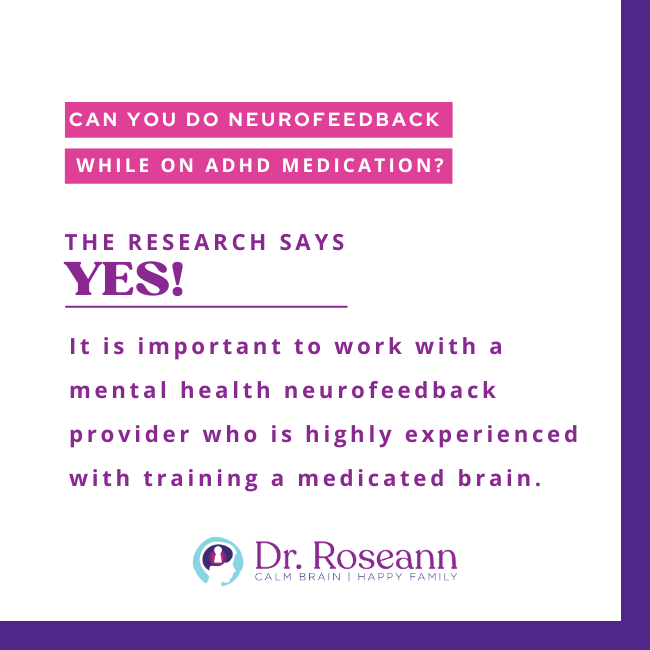
A common question among parents and individuals with ADHD who are considering neurofeedback as a natural ADHD treatment is whether they can continue taking their ADHD medication while undergoing treatment. The short answer is yes, it is possible to do neurofeedback while on ADHD medication. Many individuals choose to combine neurofeedback with medication or use it as a treatment to discontinue medication with the help of their prescribing physician.
While medication can help manage ADHD symptoms, it does not address the underlying brain dysfunction that is often present in individuals with ADHD. Neurofeedback, on the other hand, targets the root cause of ADHD by training the brain to produce optimal brainwave patterns. By doing so, neurofeedback can help individuals with ADHD reduce their reliance on medication over time.
That being said, there are some factors to consider when combining neurofeedback and medication. For example, some medications can affect brainwave patterns and may interfere with neurofeedback training. Additionally, it is important to work with a highly experienced mental health practitioner, such as Dr. Roseann, who has experience working with individuals who are on medication.
One study by Arns et al. (2013) investigated the effects of medication on neurofeedback treatment for ADHD. The study found that medication did not have a significant impact on the effectiveness of neurofeedback and that individuals who were taking medication during neurofeedback training showed similar improvements in ADHD symptoms as those who were not taking medication.
While medication can be helpful for some when managing symptoms in the short-term, neurofeedback targets the underlying brain dysfunction that is often present in individuals with ADHD safely and effectively. And with the dangerous side effects that ADHD medication poses, parents need safe alternatives that can help their child do better in school and at home.
Is Neurofeedback Effective for ADHD?
The basic premise of neurofeedback for ADHD is to train individuals to regulate their brainwave patterns. This typically involves real-time monitoring of brain activity, with individuals receiving feedback, often visual or auditory, when their brainwave patterns align with desired targets. The goal is to help individuals learn self-regulation and potentially improve ADHD symptoms.
Neurofeedback for ADHD is thought to be effective by providing real-time feedback on individuals' brainwave patterns, aiming to train them in self-regulating irregularities associated with attention and impulse control.
This process relies on operant conditioning principles, reinforcing desired brainwave patterns during sessions to promote voluntary control and adaptability. The targeted training of specific brain regions, particularly the prefrontal cortex, aims to enhance cognitive functions.
Neurofeedback leverages the brain's neuroplasticity as repeated sessions can create lasting improvements by establishing new neural pathways. Neurofeedback is often considered a complementary intervention within a comprehensive ADHD treatment plan.
Why Is Neurofeedback Controversial?
Neurofeedback is controversial due to mixed research results and study design issues, with some studies suggesting positive outcomes while others show minimal significant benefits. Methodological challenges, including small sample sizes and variability in protocols, contribute to difficulties in drawing definitive conclusions about its effectiveness.
Additionally, the subjective nature of conditions like ADHD and anxiety poses challenges in distinguishing actual effects from the placebo effect, as positive expectations may influence reported outcomes.
The controversy is further fueled by concerns about commercialization and exaggerated claims by some practitioners and companies, raising expectations without sufficient scientific support. Conditions' heterogeneity adds complexity, as neurofeedback may be more effective for specific subtypes or presentations.
The lack of standardization in neurofeedback protocols among practitioners makes it challenging to establish a consistent, evidence-based framework. Ethical concerns also arise, with questions about the promotion and delivery of neurofeedback services, including charging for treatments that lack proven effectiveness.
Can Neurofeedback Cure ADHD?
Neurofeedback, a form of biofeedback aiming to regulate brainwave patterns, has shown potential benefits in reducing ADHD symptoms according to some studies. However, it is not universally acknowledged as a cure for ADHD due to the disorder's heterogeneity, with effectiveness varying across individuals and aspects of symptoms.
Given the complex nature of ADHD, which manifests in different subtypes and presentations, a comprehensive treatment approach is typically employed, involving behavioral interventions, psychoeducation, and familial support. Neurofeedback, if integrated, is often seen as a complementary or alternative element within this multifaceted strategy rather than a standalone cure.
Is Neurofeedback Effective for ADHD?
Neurofeedback is theorized to work for ADHD by regulating brainwave patterns, particularly in areas associated with attention and impulse control. This process involves real-time monitoring, with individuals receiving positive reinforcement, such as visual or auditory feedback, during sessions to strengthen neural pathways.
The underlying principle relies on neuroplasticity, allowing the brain to adapt and form more efficient connections over repeated sessions, potentially leading to improved cognitive functions and reduced ADHD symptoms. The ultimate goal is to teach individuals self-regulation skills, with neurofeedback protocols tailored to each person's unique brainwave patterns and symptoms, recognizing the heterogeneity of ADHD.
Why We Do ADHD Treatment Neurofeedback
If you have heard me speak, then you may know the story of why I even began using neurofeedback with my patients… it all began with a little boy named Alec.
There I was sitting in my office in Ridgefield, CT, tapping my pen on my desk wondering how I was going to help this boy who was struggling so hard with ADHD. If I looked away, Alec literally would be climbing the walls and contorting his body to the point that he looked like he was having a seizure. At the tender age of eight, he got in trouble practically every minute at school. His mother came to me out of desperation looking for a way to help her bright, blue-eyed boy.
Even though I was personally holistic, my traditional training was psychotherapy and psychopharmacology, so I recommended a consult with a psychiatrist thinking that I was going to help this little cutie pie and his worried family.
He was unfocused, couldn’t put his thoughts down on the page, and was always on the red light on the behavioral chart. Alec began a course of treatment with several ADHD medications that resulted in frightening side effects. His heart rate increased His energetic personality went flat.
He no longer enjoyed anything. The drugs made him cranky and reduced his eating which was worrisome since he was already a wiry kid. Then there were so many sleepless nights to boot. His parents were beside themselves, but they were determined. In those early days of the internet, they found neurofeedback and were elated at the possibility of something natural with decades of research behind it.
Off they went, seeking treatment. Within a few months, Alec’s best features began to shine – not only was he focused but he was able to put his thoughts together, and connect with others, and joyous laughter came for the first time! He was happy that he wasn’t in trouble all the time.
The impulsive, unfocused Alec was gone and I was a believer! Neurofeedback became my passion too. My eyes were opened to the deep healing that happens with natural therapies that support the brain and body.
And ever since I got to meet Alec, I made it my mission to help thousands of children and families. At my office, that is just what we’ve done! Every day, we use evidence-based holistic therapies to cultivate happiness, hope, and change in children, individuals, and families.
If you're a worried parent, and you want to see your child go from a stressed-out mess to a happy and focused kid, then you are ready for our BrainBehaviorReset™ Program or other solutions we have.
Parent Action Steps
☐ Research about ADHD and neurofeedback therapy to gain understanding.
☐ Schedule a consultation and consider a QEEG Brain Map for diagnostic insights.
☐ Discuss neurofeedback benefits and its non-invasive and medication-free approach.
☐ Collaborate with healthcare providers.
☐ Communicate between neurofeedback specialists and healthcare professionals.
☐ Emphasize the need for personalized neurofeedback plans for your child.
☐ Make decisions based on scientific evidence and professional advice.
☐ Begin neurofeedback to assess comfort and responsiveness for continued therapy.
☐ Explore combining neurofeedback with existing ADHD medication.
☐ Commit to a regular neurofeedback schedule, which often requires multiple sessions.
☐ Monitor progress, stay in communication with practitioners, and adjust as needed.
☐ Take the ADHD Quiz to know if your child has ADHD or something else.
☐ Try the Solutions Matcher for a personalized treatment for your child.
Citations
Arns, M., de Ridder, S., Strehl, U., Breteler, M., & Coenen, A. (2009). Efficacy of neurofeedback treatment in ADHD: The effects on inattention, impulsivity, and hyperactivity: A meta-analysis. Clinical EEG and Neuroscience, 40(3), 180-189. https://doi.org/10.1177/155005940904000311
Arns, M., Heinrich, H., & Strehl, U. (2014). Evaluation of neurofeedback in ADHD: The long and winding road. Biological Psychology, 95, 108-115. https://doi.org/10.1016/j.biopsycho.2013.11.013
Bakhshayesh, A. R., Hänsch, S., Wyschkon, A., Rezai, M. J., & Esser, G. (2011). Neurofeedback in ADHD: A single-blind randomized controlled trial. European Child & Adolescent Psychiatry, 20(9), 481-491. https://doi.org/10.1007/s00787-011-0208-y
Gani, M., & Birbaumer, N. (2014). Not all minds that wander are lost: The importance of a balanced mind-wandering state in learning and development. Frontiers in Psychology, 5, 00530. https://doi.org/10.3389/fpsyg.2014.00530
Heinrich, H., Gevensleben, H., & Strehl, U. (2007). Annotation: Neurofeedback – train your brain to train behaviour. Journal of Child Psychology and Psychiatry, 48(1), 3-16. https://doi.org/10.1111/j.1469-7610.2006.01665.x
Steiner, N. J., Frenette, E. C., Rene, K. M., Brennan, R. T., & Perrin, E. C. (2014). In-school neurofeedback training for ADHD: Sustained improvements from a randomized control trial. Pediatrics, 133(3), 483-492. https://doi.org/10.1542/peds.2013-2059
Sherlin, L. H., Arns, M., Lubar, J. F., Heinrich, H., Kerson, C., Strehl, U., & Sterman, M. B. (2011). Neurofeedback and basic learning theory: Implications for research and practice. Journal of Neurotherapy, 15(4), 292-304. https://doi.org/10.1080/10874208.2011.623089
Are you looking for SOLUTIONS for your struggling child or teen?
Dr. Roseann and her team are all about science-backed solutions, so you are in the right place!
Grab your complimentary copy of
147 Therapist-Endorsed Self-Regulation Strategies for Children: A Practical Guide for Parents
You can get her books for parents and professionals, including: It’s Gonna Be OK™: Proven Ways to Improve Your Child’s Mental Health, Teletherapy Toolkit™ and Brain Under Attack: A Resource For Parents and Caregivers of Children With PANS, PANDAS, and Autoimmune Encephalopathy.
If you are a business or organization that needs proactive guidance to support employee mental health or an organization looking for a brand representative, check out Dr. Roseann’s professional speaking page to see how we can work together.
Dr. Roseann is a Children’s Mental Health Expert and Licensed Therapist who has been featured in/on hundreds of media outlets including The Mel Robbins Show, CBS, NBC, PIX11 NYC, Today, FORBES, CNN, The New York Times, The Washington Post, Business Insider, Women’s Day, Healthline, CNET, Parade Magazine and PARENTS. FORBES called her, “A thought leader in children’s mental health.”
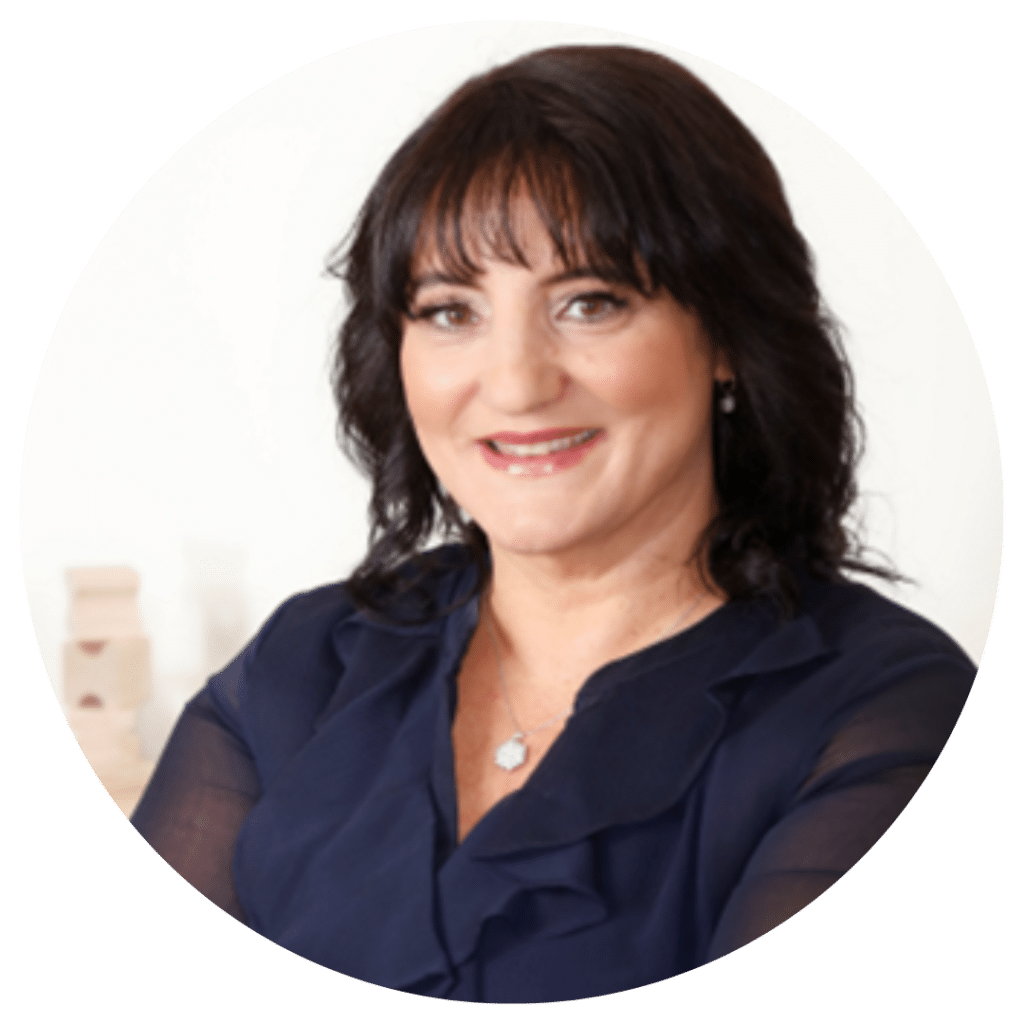
She coined the terms, “Re-entry panic syndrome” and “eco-anxiety” and is a frequent contributor to media on mental health.
Dr. Roseann Capanna-Hodge has three decades of experience in working with children, teens and their families with attention-deficit hyperactivity disorder (ADHD), autism, concussion, dyslexia and learning disability, anxiety, Obsessive Compulsive Disorder (OCD), depression and mood disorder, Lyme Disease, and PANS/PANDAS using science-backed natural mental health solutions such as supplements, magnesium, nutrition, QEEG Brain maps, neurofeedback, PEMF, psychotherapy and other non-medication approaches.
She is the author of three bestselling books, It’s Gonna Be OK!: Proven Ways to Improve Your Child's Mental Health, The Teletherapy Toolkit, and Brain Under Attack. Dr. Roseann is known for offering a message of hope through science-endorsed methods that promote a calm brain.
Her trademarked BrainBehaviorResetⓇ Program and It’s Gonna be OK!Ⓡ Podcast has been a cornerstone for thousands of parents facing mental health, behavioral or neurodevelopmental challenges.
She is the founder and director of The Global Institute of Children’s Mental Health, Neurotastic™Brain Formulas and Dr. Roseann Capanna-Hodge, LLC. Dr. Roseann is a Board Certified Neurofeedback (BCN) Practitioner, a Board Member of the Northeast Region Biofeedback Society (NRBS), Certified Integrative Mental Health Professional (CIMHP) and an Amen Clinic Certified Brain Health Coach. She is also a member of The International Lyme Disease and Associated Disease Society (ILADS), The American Psychological Association (APA), Anxiety and Depression Association of America (ADAA) National Association of School Psychologists (NASP), International OCD Foundation (IOCDF).
© Roseann-Capanna-Hodge, LLC 2023





